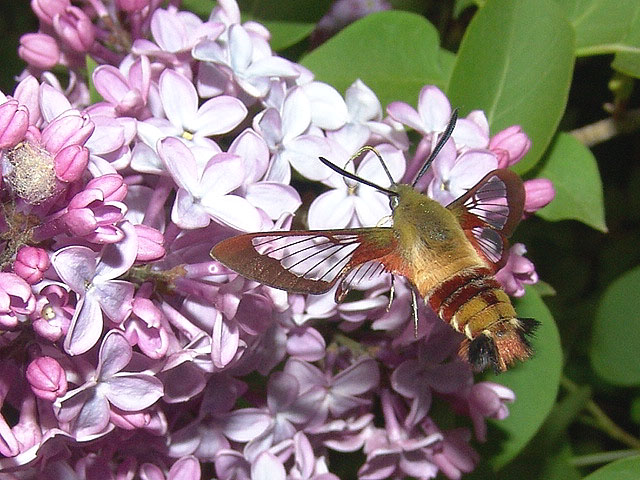
Hemaris thysbe, Peterborough, Ontario, May 22, 2007, courtesy of Tim Dyson.
This site has been created by
Bill Oehlke at oehlkew@islandtelecom.com
Comments, suggestions and/or additional information/sightings are welcomed by Bill.
|
|
Created/dedicated as per personal communication with Rachel Barnard, August 31, 2010 Updated as per James P. Tuttle's The Hawk Moths of North America, August 31, 2010 Updated as per Butterflies and Moths of North America website, formerly USGS, August 31, 2010 |

This site has been created by
Bill Oehlke at oehlkew@islandtelecom.com
Comments, suggestions and/or additional information/sightings are welcomed by Bill.
Rachel writes, "I found your website while trying to identify an amazing insect I encountered today! This is my (and my husband's) first experience seeing a hummingbird moth. I believe that it was an Hemaris thysbe. My husband and I were able to observe it at very close range and over a minute or two time span. He was able to see it in better light, but we were out for a walk and were unable to take a photo. With both of us looking at online photos of the different possible species, we came to the same conclusion- Hemaris thysbe.
"I know that no record can be made of the spotting, because we are not experts and were not able to take a photo, so there will be no official identification- but as someone who maintains a website dedicated to these beautiful insects, I thought maybe you wouldn't mind me sharing the experience. It was rather exciting for both of us!
"Just a little information, in case you are interested- we saw this hummingbird moth in Chesterton, IN which is located in northern Porter County in the northwest corner of Indiana.
Twenty-six Sphingidae species are listed for Indiana on the U.S.G.S. website. Not all of the species are reported or anticipated in Porter County (four are reported on U.S.G.S. as of August 31, 2010). It is hoped that this checklist, with the thumbnails and notes, will help you quickly identify the moths you are likely to encounter.
A "WO" after the species name indicates that I (William Oehlke) expect that this moth is present or might be present.
A "USGS" indicates the moth is reported on the USGS website and/or in Lepidoptera of North America, #1. Distribution of Silkmoths (Saturniidae) and Hawkmoths (Sphingidae) of Eastern North America, an excellent little booklet available through Paul Opler.
Please help me develop this list with improved, documented accuracy by sending sightings (species, date, location), preferably with an electronic image, via email to Bill Oehlke.
Sphinginae subfamily
Smerinthini Tribe:
Macroglossinae subfamilyDilophonotini tribe:
See Hemaris comparison
to help distinguish the next three species.
|
 | Eumorpha achemon WO, the Achemon SphinxThis moth is not officially reported for Allen County, but has been reported to north, east, south and west. Note the differences between this moth and the Pandorus Sphinx. |
 | Eumorpha pandorus WO, the Pandorus SphinxIf you have Grape or Virginia Creeper nearby, then you probably have this species. I often get reports of larvae from outside the reported range. |
 | Amphion floridensis WO, the Nessus SphinixThis day flier is widely distributed. If you have Virginia Creeper, you probably have the Nessus Sphinx. Two bright, distinct, narrow yellow bands are often visible on the abdomen. |
 | Darapsa choerilus WO, the Azalea SphinxThey are common in New Jersey and common here on Prince Edward Island, and they are probably common in Allen Co.. You will often see this species listed as Darapsa pholus, especially in older literature. |
 |
Darapsa myron
WO, the Virginia Creeper Sphinx or the Grapevine Sphinx |
 |
Darapsa versicolor
WO,
the Hydrangea Sphinx |
 | Deidamia inscriptum WO, the Lettered SphinxThe moth's outer margin of the forewing is deeply scalloped. The upperside is light brown with dark brown markings. There is a small black and white spot near the tip. The upperside of the hindwing is orange-brown with a dark brown outer margin and median line. |
 | Hyles lineata WO, the White-lined SphinxThis species has strong migrating tendancies from much further south. There are records from New Hampshire, Maine, Michigan, Illinois, etc. |
 | Sphecodina abbottii WO, the Abbott's SphinxThis moth is very much under reported across the United States. It is a rapid day flier so is probably not in too many collections. Grape is a popular larval host. I have taken it is Pottersville. |
Enjoy some of nature's wonderments, giant silk moth cocoons. These cocoons are for sale winter and fall. Beautiful Saturniidae moths will emerge the following spring and summer. Read Actias luna rearing article. Additional online help available.
Eggs of many North American species are offered during the spring and summer. Occasionally summer Actias luna and summer Antheraea polyphemus cocoons are available. Shipping to US destinations is done from with in the US.
Use your browser "Back" button to return to the previous page.
This page is brought to you by Bill Oehlke and the WLSS. Pages are on space rented from Bizland. If you would like to become a "Patron of the Sphingidae Site", contact Bill.
Please send sightings/images to Bill. I will do my best to respond to requests for identification help.
 Show appreciation for this site by clicking on flashing butterfly to the left. The link will take you to a page with links to many insect sites. |